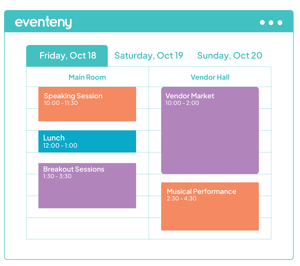The Orlando area transforms into a hub of vibrant activity and gratitude every Thanksgiving week....
Creating an interactive schedule with event scheduling software
In the busy world of event planning, being ahead of the game is important to make sure attendees have a great time. We no longer rely on basic schedules pinned to boards; nowadays, it's all about creating interactive schedules. Event scheduling software has changed how we make schedules, with lots of added features to get guests involved and make planning easier.
Let's explore why having an interactive schedule is essential and how event scheduling software can help you achieve that.
Table of contents
- Importance of an interactive schedule
- Understanding event scheduling software
- Leveraging tracks, tags, and added features
- Utilizing color coding
- Connecting participants to sessions
- Creating an interactive map
- Boosting sales with interactive maps
- Tips to maximize your event scheduling software
- Conclusion
Importance of an interactive schedule
Interactive schedules are key to modern event planning, providing attendees with a seamless and enjoyable experience. In today's fast-paced digital age, attendees expect quick and easy access to event information, and a user-friendly digital schedule is essential to meet these expectations.
By offering attendees a digital schedule at their fingertips, they can easily navigate the numerous sessions and activities available at the event. This not only enhances their overall event experience but also enables them to make the most of their time by attending sessions that align with their specific interests and preferences. Ultimately, a well-crafted interactive schedule ensures that attendees can fully immerse themselves in the event, creating lasting memories and meaningful connections.
Understanding event scheduling software
What is an event scheduling software?
Event scheduling software is the backbone of modern event planning, offering many tools to streamline the process. This event management tool provides a platform where organizers can create, organize, and share event schedules, manage attendee registrations, and handle other essential tasks related to event management.
In this case, it will help organizers create, handle, and share schedules without the fuss. This saves time for the event organizer and streamlines the event organizing process for team members helping out with the event.
Leveraging tracks, tags, and added features
Tracks and tags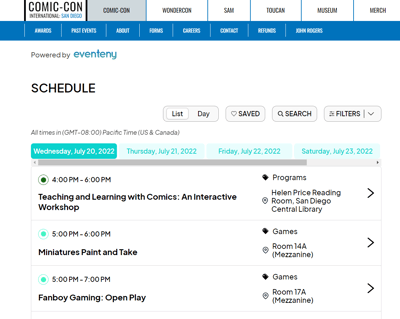
Creating an interactive event schedule relies on key elements like tracks, tags, and locations. These help attendees customize their experience to fit any type of event.
With the option to filter schedules based on different criteria, attendees can easily find sessions that match their interests, saving them from having to scroll through a messy list of sessions. Eventeny also lets attendees 'favorite' sessions they're interested in, which helps attendees keep track of what event they want to attend the most.
Tracks are like categories that group similar events together, making it easier to organize your schedule. On the other hand, tags organize events further by breaking the categories into smaller groups. For example, you can use tags to find sessions related to networking, photo ops, Q&A, and more.
Added features
Another helpful feature is the multi-day overview, which gives attendees a sneak peek at what's coming up. This helps attendees plan and navigate their schedules to pick out the sessions they don't want to miss.
Eventeny even lets event planners import schedules from Excel sheets for their custom events. This saves event organizers time and effort so that event organizers don't have to create an interactive schedule from scratch. It makes event planning smoother and gives attendees a more personalized and easy-to-use experience.
Utilizing color coding
Sorting sessions and activities are good, but color coding is a great way to organize information visually. Not only is this more pleasing to the eye, but it also makes it easier for attendees to find what they are looking for at a glance.
You can use this feature by assigning different colors to sessions. By sorting the sessions out based on the type of event, attendees will be able to quickly find what they need. Having this event planning tool will help make your schedule more engaging and accessible to all participants.
Connecting participants to sessions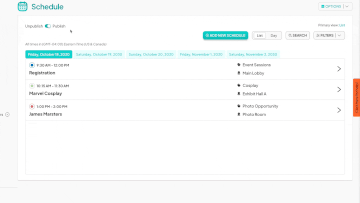
An interactive schedule allows for a connection between participants and sessions, encouraging collaboration. Organizers connect artists, vendors, exhibitors, and speakers to their sessions so that attendees can learn more about the speaker's background. This gives attendees better insight into what to expect when it comes time to attend a session.
Creating an interactive map
An essential part of an interactive schedule is a dynamic map that helps attendees easily navigate the event. Organizations can create interactive maps with event scheduling software that showcase session locations, exhibitor booths, and more. This makes it more helpful for attendees to find the session locations outlined in the schedule. If you want to learn more about interactive maps and organizing vendors, Eventeny has an entire blog dedicated to interactive maps and the benefits of looking for an event scheduling software that has one.
Using a mobile app
Interactive scheduling is important in today's event planning world. To take this convenience to the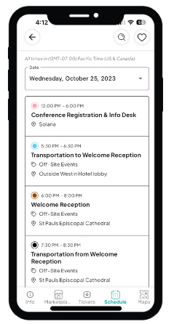 next level, event scheduling software with a mobile app is a must.
next level, event scheduling software with a mobile app is a must.
With mobile apps, attendees can easily access schedules and maps with just a few taps. Simply download the app and search for the event, and all the essential information needed is just a tap away. In addition, attendees can personalize their schedules, bookmark their favorite sessions, and stay informed about any changes or additions to the event without the hassle.
This seamless connection between the event planning software and the mobile app enhances the attendee experience by providing a user-friendly solution that caters to their needs and preferences.
Boosting sales with interactive schedules 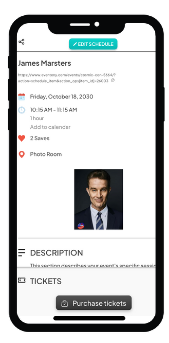
Interactive schedules are useful tools for attendees and valuable assets for event organizers looking to boost sales and revenue.
Event organizers can make a profit on this feature by offering individual session tickets directly through the schedule. With this feature, you can purchase the event ticket with only a tap, boosting ticket sales by streamlining the ticketing process and encouraging attendees to invest in a premium experience. By using interactive scheduling, organizers drive engagement and maximize revenue potential.
Tips to maximize your event scheduling software
Having event scheduling software is important, but to maximize its benefits, certain tips should be kept in mind when using this tool.
Utilize customization options
Take advantage of the software's customization options to tailor your event schedule to meet your audience's specific needs. Customize the layout, colors, and fonts to match your branding, and add interactive elements such as polls, surveys, and Q&A sessions to engage attendees.
Promote your schedule
Once you've created your event schedule, make sure to promote it effectively to maximize attendance and engagement. Encourage attendees to download the event app that comes with the event scheduling software. Eventeny has an embed feature that allows event organizers to embed the schedule they created directly on their website.
Gather feedback
After your event, gather feedback from attendees to learn what worked well and what could be improved for future events. Eventeny's all-in-one event management platform has a survey feature that can collect responses and analyze data from your event. You can incorporate this feedback into your event planning process to improve your next event.
By following these tips, you can make the most of your event scheduling software and create seamless, engaging experiences for your attendees. No matter the event - whether it be a conference, a festival, an expo, or a parade, using the right software can help you stay organized, save time, and deliver a memorable event for everyone involved.
Conclusion
To conclude, an event management tool dedicated to event scheduling is vital when planning an event.
Looking for an event technology that can create an interactive schedule is essential in the event space. An event management software provides a complete solution with interactive schedules to improve attendee satisfaction and simplify planning. Event planners can use tracks, tags, tickets, and color coding to make events more exciting for guests and increase profits. By using an event management platform that has these features, you can give attendees a great interactive experience.
Want to stay in the loop? Subscribe here to keep up with the latest news!

